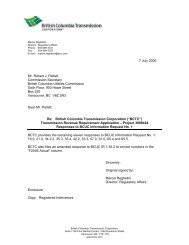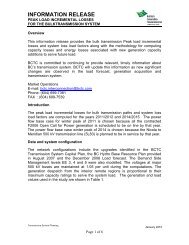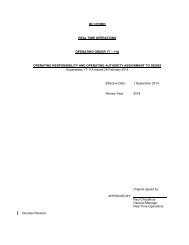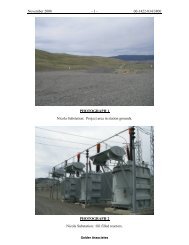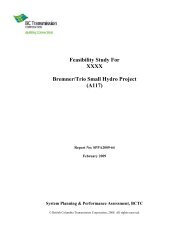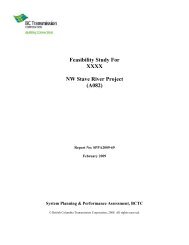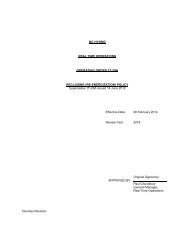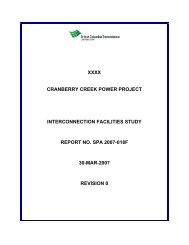Evidence on the Adequacy of First Nations Consultation - BC Hydro ...
Evidence on the Adequacy of First Nations Consultation - BC Hydro ...
Evidence on the Adequacy of First Nations Consultation - BC Hydro ...
Create successful ePaper yourself
Turn your PDF publications into a flip-book with our unique Google optimized e-Paper software.
Shuswap. However, he was told by Louis Joseph that “The Columbia Lakes were never attacked by<br />
Shuswap shamans” [Vol. VI, p. 52]. This indicates an amicable sharing <strong>of</strong> territory began after <strong>the</strong><br />
Ktunaxa agreed to <strong>the</strong>ir settling in <strong>the</strong> Windermere area.<br />
Schaeffer’s work does not appear to be a comprehensive examinati<strong>on</strong> <strong>of</strong> traditi<strong>on</strong>al territory but his<br />
field notes al<strong>on</strong>e indicate that <strong>the</strong> Ktunaxa had a str<strong>on</strong>g interest in <strong>the</strong> upper Columbia down to Boat<br />
Encampment and were known to pass through <strong>the</strong> Yellowhead Pass to <strong>the</strong> plains east <strong>of</strong> <strong>the</strong> Rockies.<br />
4. Harry Holborn Turney-High<br />
Perhaps <strong>the</strong> best known published ethnography <strong>of</strong> <strong>the</strong> Kutenai was written by Turney-High in 1941<br />
following several summers <strong>of</strong> detailed field work primarily am<strong>on</strong>g <strong>the</strong> Upper Ktunaxa. The model<br />
adopted by Turney-High for determining traditi<strong>on</strong>al territory was essentially based <strong>on</strong> whe<strong>the</strong>r <strong>the</strong><br />
Ktunaxa could travel and collect food in a place without fear <strong>of</strong> attack by ano<strong>the</strong>r tribe. This<br />
c<strong>on</strong>trasts with <strong>the</strong> delineati<strong>on</strong> <strong>of</strong> Salish territory based <strong>on</strong> place names employed by Teit and Ray.<br />
The author summarizes <strong>the</strong> limits <strong>of</strong> Kutenai territory largely as given to him by Chief Paul <strong>of</strong><br />
Tobacco Plains [p. 23], noting “His descripti<strong>on</strong> was so accurate that verificati<strong>on</strong> am<strong>on</strong>g <strong>the</strong> o<strong>the</strong>r<br />
bands c<strong>on</strong>tributed <strong>on</strong>ly minor correcti<strong>on</strong>s.” According to his map [Figure 6], <strong>the</strong> nor<strong>the</strong>rn boundary<br />
<strong>on</strong> <strong>the</strong> east appears to be held at <strong>the</strong> Blaeberry River a short distance north <strong>of</strong> Golden and <strong>on</strong> <strong>the</strong> west<br />
in <strong>the</strong> vicinity <strong>of</strong> Revelstoke.<br />
On <strong>the</strong> north <strong>the</strong> Kutenai c<strong>on</strong>sidered <strong>the</strong>ir land to be marked by a small stream which runs into <strong>the</strong><br />
Columbia <strong>on</strong> <strong>the</strong> o<strong>the</strong>r side <strong>of</strong> Golden, or at about D<strong>on</strong>ald, B.C.<br />
The eastern boundary was clearly marked by <strong>the</strong> Rocky Mountains. Once <strong>on</strong> <strong>the</strong> o<strong>the</strong>r side, Kutenai<br />
parties were challenged by <strong>the</strong> Blackfoot bands. The Kutenai did c<strong>on</strong>sider <strong>the</strong> eastern face <strong>of</strong> <strong>the</strong><br />
Rockies <strong>the</strong>irs, however, and maintained <strong>the</strong>ir right to hunt <strong>the</strong>re…<br />
He accepts <strong>the</strong> more c<strong>on</strong>servative word <strong>of</strong> <strong>the</strong> B<strong>on</strong>ner’s Ferry Ktunaxa in placing <strong>the</strong> sou<strong>the</strong>rn<br />
boundary at Flat Head Lake in M<strong>on</strong>tana, bey<strong>on</strong>d which <strong>the</strong>y would be challenged by <strong>the</strong> Pend<br />
d’Oreille Indians. The western boundary, according to his informants, extended to <strong>the</strong> western shore<br />
<strong>of</strong> <strong>the</strong> Arrow Lakes.<br />
With reference to this map <strong>of</strong> Ktunaxa territory [Figure 9], Turney-High’s informants told him that<br />
<strong>the</strong>y were free to range throughout <strong>the</strong> area shown. The dotted areas in <strong>the</strong> sou<strong>the</strong>rn and western<br />
porti<strong>on</strong>s <strong>of</strong> <strong>the</strong> range indicate traditi<strong>on</strong>al lands claimed by his Ktunaxa informants but questi<strong>on</strong>ed by<br />
authorities such as Ray. His own doubts lead to follow up interviews, after which he wrote:<br />
With but <strong>on</strong>e excepti<strong>on</strong> <strong>the</strong>y all claimed Arrow Lake and its shores, although admitting <strong>the</strong>re were no<br />
Kutenai villages <strong>the</strong>re. They said that <strong>the</strong> lake was <strong>on</strong>e <strong>of</strong> <strong>the</strong>ir important sources <strong>of</strong> fish, that <strong>the</strong>ir<br />
fa<strong>the</strong>rs regularly visited it by canoe, and that <strong>the</strong>y expected to find no enemy or rival <strong>the</strong>re or <strong>on</strong> <strong>the</strong><br />
way <strong>the</strong>re…While <strong>the</strong> majority opini<strong>on</strong> is <strong>the</strong> <strong>on</strong>e represented <strong>on</strong> <strong>the</strong> map in this work, it must be<br />
c<strong>on</strong>sidered a moot point.<br />
38<br />
Page 182 <strong>of</strong> 200






